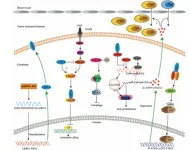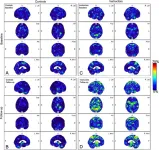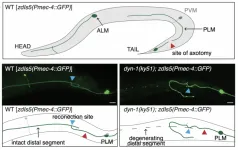(Press-News.org) We’ve all recently gotten a crash-course in drug repurposing, thanks to near-daily news reports about efforts to identify existing medicines that could help treat COVID-19 in the early phase of the pandemic. A team of scientists at the Wyss Institute at Harvard University jumped into the fray in the spring of 2020, applying novel computational drug repurposing approaches to confront the COVID-19 challenge. This early work led to the surprising prediction that a some, but not all, types of statins (drugs that are widely prescribed to lower cholesterol) might protect patients against SARS-CoV-2 infection. In the flurry of clinical studies being published by other scientists studying COVID-19, some found that statins seemed to reduce mortality in COVID-19 patients, while others found no effect – but these studies did not discriminate between different types of statin drugs.
Now, the Wyss team along with collaborators at Stanford University and University of California, San Francisco (UCSF) have confirmed that only a subset of them, including simvastatin (Zocor®) and atorvastatin (Lipitor®), reduce mortality risk in COVID-19 patients. The team also demonstrated that simvastatin potently inhibited the virus and reduced the production of inflammatory cytokines, while other statins did not.
“This work helps to illuminate the fact that the biomedical community doesn’t fully understand the mechanisms of action of drugs that are very, very commonly prescribed. There’s a lot of work that can be done to study the multiple functions of drugs to discover new uses for existing medications,” said co-first author Megan Sperry, Ph.D., a Postdoctoral Fellow at the Wyss Institute. The research is published in PLOS Computational Biology.
Predicting potency
It has been recognized for some time in the field of statin research that even though all statins target an enzyme called HMGCR to reduce cholesterol, different drugs seem to exert different effects on patients. But the impetus (and funding) to tease out what exactly those are was lackluster until COVID-19 came along. As part of its effort to stem the tide of the pandemic, the United States’ Defense Advanced Research Projects Agency (DARPA) awarded the Wyss Institute $16 million in the spring of 2020 to identify and test FDA-approved drugs that could be repurposed to prevent or treat COVID-19. Statins were among the compounds evaluated by the Wyss team using a computational tool they had developed with prior DARPA funding called Network Model for Causality-Aware Discovery (NeMoCAD).
NeMoCAD uses a network analysis-based algorithm to predict drugs that could revert a diseased gene network back to a healthy gene network; in this case, gene networks found in tissue samples from COVID-19 patients versus those in healthy patient samples. Any drugs that NeMoCAD predicted would be able to convert diseased gene networks into healthy gene networks would then be further tested using cell culture, human Organ Chips, and animal models.
The researchers analyzed 2,436 drugs with NeMoCAD, and noticed that a subset of statin drugs were among those predicted to restore a COVID-19 state to a healthy state, including simvastatin, atorvastatin, pravastatin (Pravachol®), lovastatin (Altoprev®), and fluvastatin (Lescol®). However, only simvastatin and atorvastatin were ranked as highly protective; the others showed a much weaker predicted effect, even though all statins share a common, well-defined mechanism of action against their target.
These observations and similar in vitro experimental data led the Wyss team to conclude that statins varied sufficiently in their effects against SARS-CoV-2 to warrant a deeper dive to determine which individual drugs could potentially treat COVID-19.
Meanwhile, other scientists around the world studying COVID-19 started to publish research showing that patients taking statins seemed to be protected against the worst effects of SARS-CoV-2 infection. But these studies had classified the entire category of “statins” as effective, while the Wyss team knew from their NeMoCAD studies that it was highly likely that only a subset of statins were actually protective.
Co-senior author Richard Novak, Ph.D. reached out to teams at Stanford University and UCSF that had published some of this work on statins, proposing that they collaborate with the Wyss researchers to unravel the distinct effects of specific statins within their dataset. Novak recognized two features of this patient population that made it especially optimal for further study: people taking statins had similar risk factor profiles (i.e., high cholesterol), and doctors prescribe statins interchangeably, effectively randomizing which patients had received which statin.
One drug comes out on top
Together, the groups performed a retrospective analysis of more than 4,000 patients who were actively taking statins when they became infected with SARS-CoV-2. The results showed that only simvastatin and atorvastatin correlated with significantly increased survival in COVID-19 patients. This confirmed that not all statins have the same effects on the human body, despite their molecular similarity.
Additional in vitro studies in living cells found that only simvastatin strongly inhibited the virus’ ability to infect non-human primate cells; the other statins tested were either ineffective or toxic at the dose required to achieve any effect. Simvastatin also inhibited the infection of human cells with a related coronavirus known as OC43 and reduced the levels of multiple inflammatory cytokines without causing toxicity. The results from both the patient data and the in vitro studies also largely matched NeMoCAD’s original predictions about which statins would be effective against SARS-CoV-2 infection.
“Thanks to the availability of large amounts of clinical patient data and the Wyss Institute’s multidisciplinary capabilities, we were able to go deeper than previous studies by using multiple models and types of analysis to determine how different statins affect rates of infection and the body’s immune response,” said Novak, who was a Lead Staff Engineer at the Wyss Institute when the research was performed. “Ultimately, this paper demonstrates how we can combine the diverse tools we have in the lab in a deliberate manner to better understand how drugs work and enable more rapid repurposing for future pandemics or other clinical needs.” Novak is currently the CEO and co-founder of Unravel Biosciences.
The Wyss team is continuing to use this approach to uncover drugs that can be repurposed for various uses, including putting tissues or whole organisms into a state of biological “suspended animation” to extend the amount of time they can survive before getting treatment.
“Drugs are approved for a single use in the human body, but the existence of what we commonly call ‘side effects’ for nearly every medication strongly suggests that these compounds actually affect multiple biological systems,” said corresponding author and leader of the DARPA COVID-19 program, Donald Ingber, M.D., Ph.D., who is the Wyss Institute’s Founding Director, Judah Folkman Professor of Vascular Biology at Boston Children's Hospital and Harvard Medical School, and Hansjörg Wyss Professor of Bioinspired Engineering at Harvard John A. Paulson School of Engineering and Applied Sciences. “Studies like this one are a very clear demonstration that off-target effects of FDA-approved drugs can and should be characterized and harnessed in useful ways to address pressing problems in human health.”
Additional authors of the paper are co-first author Tomiko Oskotsky, co-senior author Marina Sirota, Idit Kosti, and Brian Le from UCSF; Ivana Marić, Ronald Wong, and David Stevenson from Stanford University; current Wyss Institute members Viktor Horvath, Pranav Prabhala, Girija Goyal, Ken Carlson, Melissa Rodas, and Brooke Furlong; former Wyss Institute members Shruti Kaushal, Takako Takeda, Rani Powers, and Mercy Soong; and James Logue, Holly Hammond, and Matthew Frieman from the University of Maryland.
This research was supported by DARPA under Cooperative Agreement HR0011-20-2-0040, the Wyss Institute for Biologically Inspired Engineering at Harvard University the Christopher Hess Research Fund, the University of California, San Francisco, Program for Breakthrough Biomedical Research, grant T32GM007618 from the Medical Scientist Training Program, and grant R35GM138353 from the National Institutes of Health.
END
Not all statins are created equal
Computational tools, medical record analysis, and in vitro experiments reveal that statin drugs differ in their ability to increase survival of COVID-19 patients
2023-05-09
ELSE PRESS RELEASES FROM THIS DATE:
Motion capture and 3D scans bring history to life for new Dambusters docudrama
2023-05-09
A new docudrama featuring the attack on the Sorpe Dam, using motion capture technology and 3D scans to create life-like digital representations of RAF 617 Squadron aircrew, is being premiered in Bristol on 13 May 2023 to coincide with the 80th anniversary of the Dambusters raid.
Bristol-based film maker Andrew Panton worked with University of Bath researchers at CAMERA, using the latest digital technology to recreate specific scenes for a film featuring the attack on the Sorpe Dam.
Andrew started working on the documentary in 2017 with the last surviving Dambuster George ...
Exploring the underground connections between trees
2023-05-09
Fungal networks interconnecting trees in a forest is a key factor that determines the nature of forests and their response to climate change. These networks have also been viewed as a means for trees to help their offspring and other tree-friends, according to the increasingly popular “mother-tree hypothesis”. An international group of researchers re-examined the evidence for and against this hypothesis in a new study.
Trees in a forest are interconnected through thread-like structures of symbiotic fungi, called hyphae, which together form an underground network called a mycorrhizal network. While it is well known that ...
New research sheds light on how human vision perceives scale
2023-05-09
Researchers from Aston University and the University of York have discovered new insights into how the human brain makes perceptual judgements of the external world.
The study, published on 8 May in the journal PLOS ONE, explored the computational mechanisms used by the human brain to perceive the size of objects in the world around us.
The research, led by Professor Tim Meese, in the School of Optometry at Aston University and Dr Daniel Baker in the Department of Psychology at University of York, tells us more about how our visual system can exploit ‘defocus blur’ to infer perceptual scale, but that it does ...
Chinese Medical Journal article reviews role of gene involved in brain functions and disorders
2023-05-09
Leucine-rich repeats containing 4 (LRRC4)—a gene abundantly found in the brain and located on human chromosome 7q31–32—plays a pivotal role in memory formation, autism, spinal cord injury, as well as in determining the malignant potential, development, and progression of glioblastoma (GB), an aggressive cancer involving the brain and/or spinal cord. In a review article published (in volume 136 issue 1 on 5 January 2023, and online on 10 February 2023) in the Chinese Medical Journal, researchers shed light on the ...
EuroPCR 2023 – The interventional cardiovascular community is gathering in Paris to learn, share, and shape the future of patient care worldwide
2023-05-09
EuroPCR, the annual world-leading Course in interventional cardiovascular medicine, has been taking place for over 30 years. It is tailored for all those dedicated to the sharing of knowledge and skills, and improvement of patient care worldwide: interventional cardiologists, cardiac surgeons, imaging specialists, radiologists, nurses, allied professionals and other practitioners, as well as researchers, innovators and industry representatives. The 4-day meeting addresses interventions for coronary and peripheral vessels, for the structural heart including valves, for hypertension, heart failure and stroke, while keeping the community up ...
Spanish courts hand down milder sentences for rapes if they are committed by the victim's partner or ex-partner
2023-05-09
Just four years ago, the Spanish Supreme Court pointed out in a ruling that there is no such thing as a 'conjugal debt'. In other words, a woman is not obliged to satisfy her husband's sexual needs. It may come as a surprise that this point still needs to be made, but the statistics speak for themselves. According to a national survey carried out in 2019, 7.5% of Spanish women over 16 years old have been raped by their partners or ex-partners.
These rapes are usually subject to less attention, and they tend to be "perceived as something less serious". So says Josep Maria Tamarit Sumalla, a full ...
Recurrent brain trauma may increase Alzheimer’s risk
2023-05-09
OAK BROOK, Ill. – New research finds that the brains of otherwise healthy military personnel who are exposed to explosions show an abnormal brain accumulation of amyloid-beta protein—a protein that plays a role in the development of Alzheimer’s disease. The results of the study were published today in Radiology, a journal of the Radiological Society of North America (RSNA).
Research over the last several decades suggests that there might be a relationship between repetitive or severe traumatic ...
A key protein for repairing broken nerves
2023-05-09
A study explores the role of the dynamin protein DYN-1 in axonal fusion. The axon is a long, thin protrusion of nerve cells that carries electrical impulses. Severed axons can be repaired by a highly efficient regrowth process known as axonal fusion. Previous research has shown that molecules involved in apoptosis—programmed cell death—are also involved in axonal repair. Because dynamin is involved in apoptosis, specifically in the recognition of dying cells, Brent Neumann and colleagues posited that dynamin might also be involved in axonal repair. The team severed axons in the model organism Caenorhabditis elegans, a multicellular nematode worm with just a few hundred ...
Crab populations are crashing. Could losing their sense of smell be one of the important reasons why?
2023-05-09
A new U of T Scarborough study finds that climate change is causing a commercially significant marine crab to lose its sense of smell, which could partially explain why their populations are thinning.
The research was done on Dungeness crabs and found that ocean acidification causes them to physically sniff less, impacts their ability to detect food odours and even decreases activity in the sensory nerves responsible for smell.
“This is the first study to look at the physiological effects of ocean acidification on the sense of smell in crabs,” says Cosima Porteus, an assistant professor in the department of ...
Program Announced for NUTRITION 2023 to be held July 22–25 in Boston
2023-05-09
How do our genes affect what we eat? Can more sustainable diets also improve health? What are the best foods for living longer, fighting cancer, and staying mentally sharp as we age?
You’ll find the answers to these questions and more at NUTRITION 2023, the annual flagship meeting of the American Society for Nutrition. Join us July 22-25 in Boston for an exciting lineup of scientific symposia, educational sessions, hot-topic discussions, and award lectures covering the latest developments in nutrition science.
Get a sneak peek at the ...
LAST 30 PRESS RELEASES:
Patients with clonal hematopoiesis have increased heart disease risk following cancer treatment
Stem cell therapy for stroke shows how cells find their way in the brain
Environment: Up to 4,700 tonnes of litter flows down the Rhine each year
Maternal vaccine receipt and infant hospital and emergency visits for influenza and pertussis
Interim safety of RSVpreF vaccination during pregnancy
Stem cell engineering breakthrough paves way for next-generation living drugs
California grants $7.4 million to advance gene-edited stem cell therapy for Friedreich’s ataxia
Victoria’s Secret grant backs cutting-edge ovarian cancer research
Research paves the way for safer colonoscopy bowel prep for people with compromised gut health
JMIR Publications and Sweden's National Library announce renewal and expansion of flat-fee unlimited open access partnership for 2026
A new 3D-printed solar cell that’s transparent and color-tunable
IV iron is the cost-effective treatment for women with iron deficiency anemia and heavy menstrual bleeding
Doing good pays off: Environmentally and socially responsible companies drive value and market efficiency
City of Hope and Cellares to automate manufacturing of solid tumor CAR T cell therapy
Short-circuiting pancreatic cancer
Groundbreaking mapping: how many ghost particles all the Milky Way’s stars send towards Earth
JBNU researchers propose hierarchical porous copper nanosheet-based triboelectric nanogenerators
A high-protein diet can defeat cholera infection
A more accurate way of calculating the value of a healthy year of life
What causes some people’s gut microbes to produce high alcohol levels?
Global study reveals widespread burning of plastic for heating and cooking
MIT study shows pills that communicate from the stomach could improve medication adherence
Searching for the centromere: diversity in pathways key for cell division
Behind nature’s blueprints
Researchers search for why some people’s gut microbes produce high alcohol levels
Researchers find promising new way to boost the immune response to cancer
Coffee as a staining agent substitute in electron microscopy
Revealing the diversity of olfactory receptors in hagfish and its implications for early vertebrate evolution
Development of an ultrasonic sensor capable of cuffless, non-invasive blood pressure measurement
Longer treatment with medications for opioid use disorder is associated with greater probability of survival
[Press-News.org] Not all statins are created equalComputational tools, medical record analysis, and in vitro experiments reveal that statin drugs differ in their ability to increase survival of COVID-19 patients




